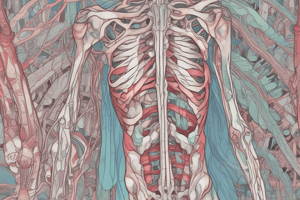Podcast
Questions and Answers
What type of connective tissue is cartilage?
What type of connective tissue is cartilage?
- Firm yet flexible (correct)
- Liquid
- Soft and porous
- Rigid and inflexible
What are the functions of cartilage?
What are the functions of cartilage?
Shock absorption from mechanical stress, viscoelastic properties, covers articulating surfaces, framework for bone formation, role in bone growth.
What are chondrocytes?
What are chondrocytes?
Matrix producing cells that occupy lacunae.
What is the extracellular matrix (ECM)?
What is the extracellular matrix (ECM)?
What is chondronectin?
What is chondronectin?
What is the perichondrium?
What is the perichondrium?
What limits the thickness of cartilage?
What limits the thickness of cartilage?
How does cartilage formation occur?
How does cartilage formation occur?
What is interstitial growth in cartilage?
What is interstitial growth in cartilage?
What is appositional growth in cartilage?
What is appositional growth in cartilage?
What characterizes hyaline cartilage?
What characterizes hyaline cartilage?
What distinguishes elastic cartilage from hyaline cartilage?
What distinguishes elastic cartilage from hyaline cartilage?
What is fibrocartilage?
What is fibrocartilage?
Flashcards are hidden until you start studying
Study Notes
Cartilage Overview
- Cartilage is a firm yet flexible connective tissue made up of chondrocytes in extracellular matrix (ECM).
- Three main types of cartilage: hyaline, elastic, and fibrocartilage.
Functions of Cartilage
- Provides shock absorption under mechanical stress.
- Exhibits viscoelastic properties, offering flexibility while resisting deformation.
- Serves as a lubricant for joints, minimizing friction and aiding movement.
- Acts as a framework for bone development during embryonic and fetal stages.
- Plays a key role in bone growth and development during adolescence.
Chondrocytes
- Chondrocytes are the cells responsible for producing the cartilage matrix.
- Their appearance varies based on location:
- Medullary chondrocytes have a rounded shape and may cluster in isogenous aggregates.
- Peripheral chondrocytes display an elliptical shape.
- Chondrocytes reside in small cavities within the matrix called lacunae, surrounded by territorial matrix.
Extracellular Matrix (ECM)
- Composed of collagen fibrils, glycosaminoglycans (GAGs), proteoglycans, and chondronectin.
- GAGs are hydrophilic polysaccharides with repeating disaccharide units.
- The chemical composition of the ECM determines its gel-like properties.
Chondronectin
- Chondronectin is a linker glycoprotein that connects chondrocytes to the ECM.
- Facilitates cell adhesion to collagen and GAGs through interaction with integrins.
Perichondrium
- A dense connective tissue layer encasing cartilage.
- Contains fibroblasts that secrete type I collagen.
- Supports the vascular and nervous supply to cartilage, promotes transition to ECM.
- Histologically appears more eosinophilic compared to the inner cartilage matrix.
Avascular Nature of Cartilage
- Cartilage lacks blood vessels, preventing calcification and hardening of its matrix.
- Chondrocytes secrete anti-angiogenic factors to inhibit blood vessel formation.
- Nutrient supply relies on diffusion from nearby vessels, limited by the absence of nerve and lymphatic networks.
- This avascularity restricts the metabolic activity of chondrocytes.
Cartilage Formation
- Derived from mesenchyme through chondrogenesis, where mesenchymal cells condense and differentiate into chondroblasts.
- Chondroblasts produce and deposit the cartilage matrix before maturing into chondrocytes.
- In mature cartilage, chondrocytes remain quiescent, residing in the perichondrium.
Growth of Cartilage
- Interstitial growth occurs via mitotic division of chondrocytes within the matrix, producing new lacunae.
- Appositional growth happens along the perichondrium’s internal edge, differentiating cells into chondrocytes, allowing for growth at the periphery.
- Interstitial growth is notable during early cartilage formation and less common in mature cartilage due to the dense matrix.
Types of Cartilage
-
Hyaline Cartilage
- Most common type, located in costal cartilage, nose, respiratory tract, and articular surfaces of bones.
- Primarily composed of type II collagen and encased in perichondrium.
- Lacks perichondrium at articular surfaces.
-
Elastic Cartilage
- Similar to hyaline cartilage but contains a larger amount of elastic fibers, providing greater elasticity and pliability.
- Found in external ears, epiglottis, and parts of the larynx.
-
Fibrocartilage
- Intermediate between dense connective tissue and hyaline cartilage.
- Found in structures like intervertebral discs and symphysis pubis, providing strength and support.
Studying That Suits You
Use AI to generate personalized quizzes and flashcards to suit your learning preferences.




